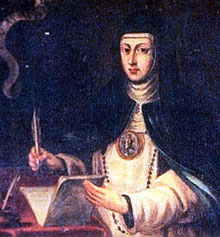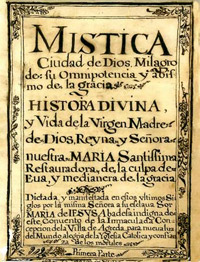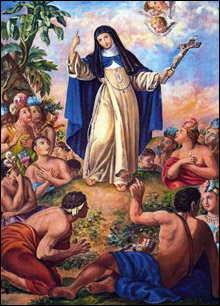 Stella Maris Media
Stella Maris Media
Author's Page: Mary of Agreda
She was the daughter of Francis Coronel and Catherine of Arana, born April 2, 1602, in the small town of Agreda near Tarazona in Spain. In 1617 she entered the convent of the discalced Franciscan Nuns in the Convent of the Immaculate Conception in Agreda and took her vows one year later. In 1625 she was chosen abbess, much against her wishes, and, except during a short intermission, was re-elected every three years until she died, in 1665.
The fame of her prudence and foresight, not only in the government of her convent but in other matters, soon spread outside the convent walls and persons of the highest rank in state and Church were eager to obtain her counsel in important affairs. King Philip IV visited her several times in her convent and corresponded with her about national affairs for many years.
But she was no less famous for her exalted virtues. In many respects her life was a faithful copy of that of St. Francis.
The miracles of bilocation related to her are in fact more remarkable and lasted a longer time than that recorded anywhere in the lives of the saints. Her good sense, her truthfulness, her sincerity, her humility, her unselfish love of God and man eminently adapted her for the communication of messages from God to men.
What induced her to write.

Though she was urged interiorly and exteriorly to record the facts of history revealed to her concerning the Mother of God, she resisted for twelve years and was finally induced to write only through the positive commands of her superiors.
Reluctantly she began her history in the year 1637 and finished it in the year 1645, continually asking to be relieved from the task because she thought herself unworthy.
As soon as the insistence of her superiors relaxed and an error of judgment on the part of an outside confessor gave her a plausible excuse, she burned all her writings, thus destroying the labor of many years. When this came to the knowledge of the higher authorities and when they insisted on her rewriting the history which continued to be supernaturally made known to her, she again succeeded in delaying the task for ten years.
Only the strictest command under obedience and the threat of censures finally induced her to write the manuscript of Mystical City of God, which she began in 1655 and finished in 1665, and which is still preserved in the convent of Agreda.
A Frequent visitor to America, a land she loved.

One of the most incredible and miraculous aspects to the life of the mystic Mary of Agreda were her multiple bilocations, or miraculous tele transportation to the current states of Texas, New Mexico and Arizona, in the United states.
Hundreds of these visits were recorded by both Native Americans as well as later by Spanish explorers and missionaries, who were speechless when establishing contact for the first time with Native American tribes and learning from them about a "Lady in Blue", who had been visiting them and preaching Christianity to them for many years.
More than 500 visits to America were carefully examined and documented by the proper authorities to ensure that there was no fraud or error. She was also carefully examined twice by the Inquisition in the years 1635 and 1650.
Mary of Agreda describes herself, in a later letter to the missionaries going to these lands, her many visits to the Jumanos and other Native American nations, from the year 1620 to 1631, "taken by the will of God, and carried by the hand and aid of His Angels".
Her profound love and compassion for these Native American people as well as innumerable details of her visits are documented in detail in Fray Alonso de Benavides' first Memorial of 1630, a detailed report on the state of the missions and colony that includes precise accounts of the natives who had been instructed by the "Lady in Blue".
Many native american nations in the United States Southwest, from one generation to another, recounted the stories of the nun in her blue cape, until our days. The Lady in Blue..